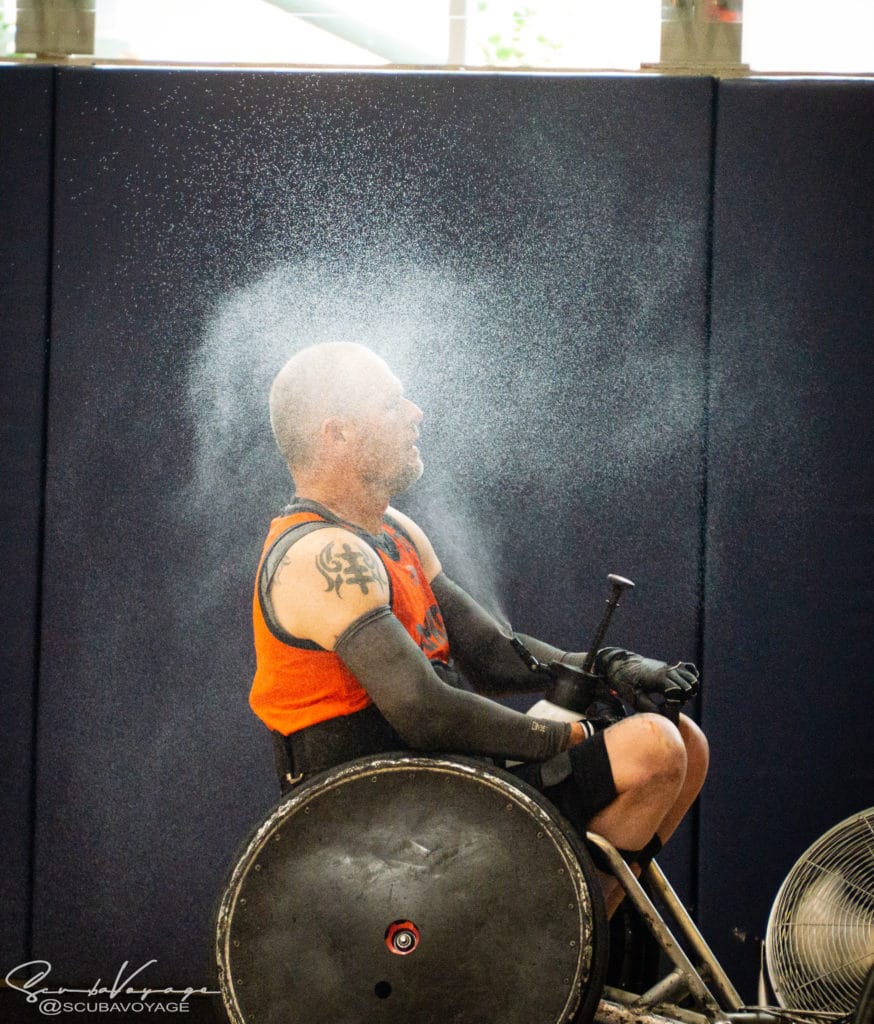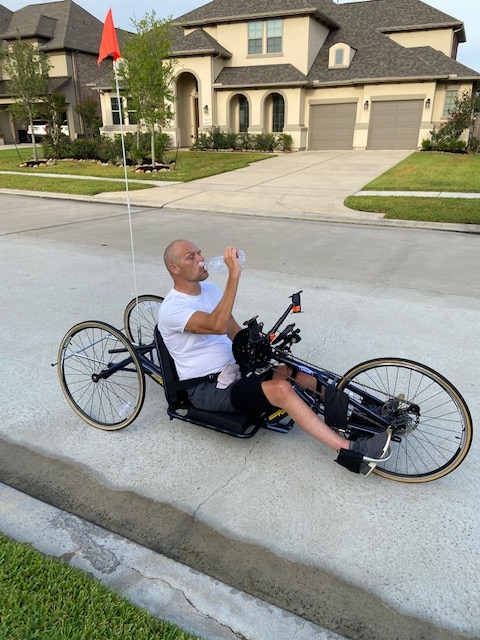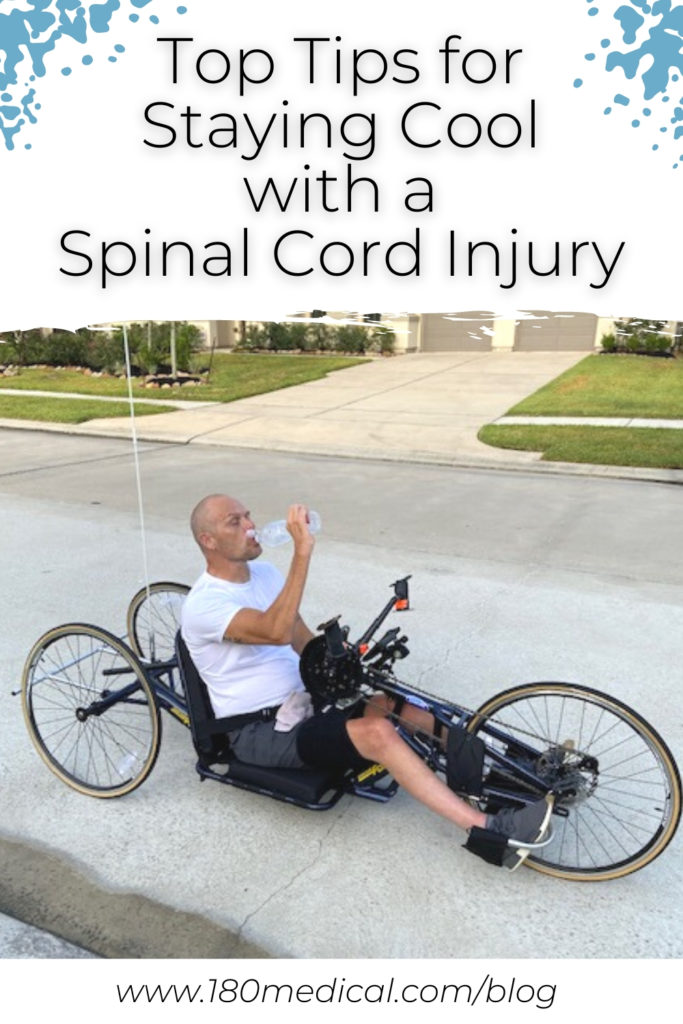My name is Steve, and I work as a Patient Advocate at 180 Medical. I have been a complete C6 quadriplegic for over 32 years now. You can learn more about my story here. Because I’m an active guy who loves to play sports and get outdoors whenever possible, I can tell you that every spinal cord-injured person should know how to avoid overheating and stay cool with a spinal cord injury.
You see, many people with spinal cord injuries are actually more susceptible to overheating than able-bodied people. So, it’s important to know how you can reduce your risk of overheating with a spinal cord injury. Let’s dig into it!

My Experience with Overheating with a Spinal Cord Injury
First, I want to tell you about one of my experiences dealing with this issue so you understand how easily it can happen. A few years after my spinal cord injury in 1988, I started playing wheelchair rugby. At the time, I was still learning about and adapting to my spinal cord injury. I was excited and happy about being active again and getting to compete in sports since I played football before I was injured. I was drawn to the physicality of the sport with its crashing wheelchairs and physical contact.
However, I was a hard-headed teenager still at just 19, and I hated drinking water because I knew I’d have to go catheterize at some point during the game. Soon after the game started, I became dehydrated, hot, and lightheaded. I wasn’t sweating. I kept playing hard, hoping the bad feelings would pass, but they didn’t.
Eventually, I passed out. The tournament ground to a halt so the emergency services could help me. Immediately, they got me out of my rugby chair, laid me down on my back, slightly elevated my legs, and put cool towels all over my head and chest.
Needless to say, that was a hard and embarrassing lesson to learn about how important it is to stay cool with a spinal cord injury. Today, as much as I still hate catheterizing in the middle of a rugby game, I would much rather drink plenty of water to stay hydrated and compete at a high level while still being safe.
Why are people with a spinal cord injury at a higher risk of overheating?
Now, let’s discuss why this is an issue for people living with spinal cord injuries. In an able-bodied person with a normally functioning nervous system, as body temperature begins to rise, signals travel to the hypothalamus, which uses that information to activate the sympathetic nervous system. At this point, the body produces sweat to start cooling down. This entire process is called thermoregulation.
However, this communication between the brain and body is usually lost after a spinal cord injury. The body no longer receives the appropriate signals to start regulating body temperature, which creates a risk of overheating in people with spinal cord injuries.
Generally, all accredited rehabilitation hospitals will discuss thermoregulation with new patients and family members. They may also discuss the body’s new warning signs when something is going wrong, such as Autonomic Dysreflexia (AD). Not understanding topics like thermoregulation and Autonomic Dysreflexia can result in some serious issues like strokes and even death. This is a very serious topic within the spinal cord-injured community.
Does the level of spinal cord injury affect thermoregulation?
The level of spinal cord injury plays a significant role in body temperature regulation. Higher-level injuries, such as quadriplegics, tend to be more affected. For example, people with spinal cord injury levels from C1 to T6 will be more sensitive to fluctuations in body temperature.
They may also experience Autonomic Dysreflexia more often, which occurs when the sympathetic nervous system overreacts to stimulations like extreme temperatures, tight clothes, or even a full bladder below the level of injury. It can create a dangerous spike in high blood pressure, which can cause noticeable symptoms like anxiety, headache, tightness in the chest, shortness of breath, and excessive sweating.
The completeness of your spinal cord injury may also affect thermoregulation. Basically, the more severe your spinal cord injury, the greater the interference between the brain and body.
Warning Signs of Overheating with a Spinal Cord Injury
Some symptoms of overheating with a spinal cord injury to watch for are:
- Weakness and fatigue
- Goosebumps or tingling skin
- Red blotches around the face and/or neck area
- Autonomic dysreflexia
- Getting dizzy or nauseous
- Change in heart rate (typically increased)
- Shortness of breath
My Top Tips for How to Stay Cool with a Spinal Cord Injury
1. Drink plenty of water and stay hydrated.
For example, when I go on long wheelchair pushes or handcycle rides, I bring 2 water bottles (one from my refrigerator and one from my freezer). The frozen water bottle starts to melt when I finish the first one from the refrigerator. On a really hot day, that cold water tastes extra good. Plus, it’s a relief to pour over your head, shoulders, etc.

2. Use a spray bottle to create artificial sweat.
It feels great, and it cools the body similar to how sweat does. If you have an ice cooler nearby, keep the spray bottle in there when not in use to keep it nice and cool.
3. Wear loose, light-colored clothing when outdoors on sunny days.
White, yellow, or orange-colored shirts tend to reflect the sun’s rays, while dark clothing tends to absorb the sun’s rays and get pretty hot.
4. Wear a cap or a wide-brim sun hat when outdoors.
I like to wear a wide-brim hat when I’m with my family on walking trails. I may look funny, but it works, and I stay cooler.

5. Try to work out or enjoy the outdoors earlier in the morning or later in the afternoon/evening.
The sun’s rays are at their strongest mid-day. By choosing to work out and be outside the house in the morning or evening, the sun’s rays hit at more of an angle. This results in less direct heat and lower temperatures typically.
6. Keep a cool or frozen towel at the ready on hot days.
I like to wet a hand towel and then place it in the freezer or ice cooler. This prepares you in advance for hot days when you’ll want to take out the towel and put it on the back of your neck, head, and shoulders. If you have multiple hand towels, rotate them in and out of the cooler to feel great all day long on a hot day.
Living with a Spinal Cord Injury
I know firsthand that life after a spinal cord injury can be difficult at times. We face many new challenges, like overheating, urinary tract infections (UTIs), learning to self-catheterize, accessibility issues, and more. However, I want you to know that 180 Medical is here for you and your catheter and incontinence product needs.
Feel free to contact us at 180 Medical for help finding products that can help turn your life around.

